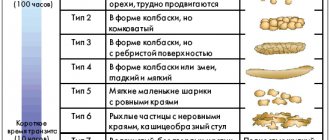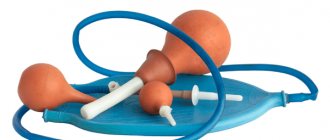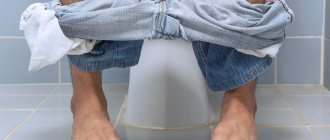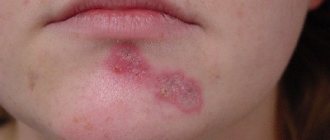September 13, 2018
Averyanova Sveta
Constipation is often called a disease of civilization. Symptoms of this deviation occur in people of any age category: adults, the elderly, children as young as one and a half years old, and even infants. Many people believe that it is not necessary to treat constipation in children and do without medical advice. Is this “inconvenient” disorder so harmless and what should you do if your baby’s potty remains empty for a long time?
Causes of constipation in infants and children under 7 years of age
Due to the anatomical and physiological imperfections of the digestive system and the influence of numerous risk factors, a single cause of the disease has not been established. Constipation in a child is a complex, polyetiological disease that has individual mechanisms of development and manifestation. The impact of risk factors and a number of other circumstances lead to a slowdown in the propulsive activity of the intestine, the accumulation of dense masses in the distal sections, and the appearance of characteristic symptoms of the pathology.
Main predisposing factors
| Prenatal | Intrapartum | Postnatal |
|
|
|
Dominant causes of constipation
Nutritional reasons
These include the following factors:
- nutritional disorders and indiscriminate feeding;
- underestimation of the baby’s individual food preferences, frequent changes of formulas;
- forced and excessive feeding (“to the last drop”);
- introducing into the diet foods that a child of this age cannot adequately digest;
- early introduction of complementary foods and transition to solid foods;
- selective nutrition (deficiency of dietary fiber, imbalance between food ingredients);
- disordered eating pattern (disordered and episodic eating).
Social and psychological reasons
These include the following factors:
- low physical activity, tight swaddling, use of diapers with tight straps, etc.;
- “potty phobia” syndrome;
- pedagogical errors in education;
- psychological depression, increased shyness;
- unformed stereotype of defecation;
- low stress resistance and lability of the child’s character.
Pathological conditions of the body
This includes the following:
- organic intestinal diseases (Hirschsprung's disease, dolichocolon and dolichosigma (elongation of intestinal sections), anal fissures, hemorrhoids;
- iron deficiency;
- rickets;
- neurological diseases (myopathies, paresis, paralysis of various origins);
- in girls, inflammatory processes of the internal genital organs;
- endocrine and metabolic diseases (diabetes mellitus, hypothyroidism, cystic fibrosis).
Use of certain groups of medications
These include:
- codeine and its derivatives;
- sedatives (phenobarbital, antidepressants, phenothiazine derivatives);
- Loperamide;
- enterosorbents;
- antacids, etc.
Types of constipation
Spicy
This type is temporary. Constipation in a child occurs infrequently and lasts only a few days.
It can be caused by changes in diet or daily routine, travel, lack of exercise, illness or medication.
You can relieve your child's severe constipation with over-the-counter laxatives, exercise, or a high-fiber diet.
Chronic
Constipation in children lasts more than three months, and sometimes continues for many years. The disorder disrupts the child's daily life. It does not go away without changing diet and physical activity, and requires the use of medications prescribed by a doctor.
Functional
Functional (idiopathic) constipation implies that there is no identifiable causative organic condition.
This type of disorder usually begins after the neonatal period. There is almost always a deliberate or subconscious retention of the stool. The acute form often precedes the chronic course. The stool becomes hard, smaller in volume and difficult to pass, which leads to irritation in the anus and the appearance of cracks.
In children under 3 years of age, forced or too early potty training may initiate bowel retention. In older children, persistent constipation may develop when the child is in a situation that does not allow bowel movements, such as at school.
As the act of defecation becomes painful, voluntary retention of feces occurs to avoid pain. Then the urge to defecate disappears, since the rectum contains all the contents. This vicious cycle gradually gets worse as the volume of stool that needs to be eliminated increases.
Syrup "Pomogusha": instructions, indications and contraindications
Baby syrup contains a large number of ingredients that have beneficial effects for the child’s body. Strawberry leaves, anise fruits, fruits, vitamins B and C improve intestinal function, balance metabolism and create a laxative effect for functional stomach disorders.
Pomogusha syrup is recommended for children as a dietary product and a mild laxative. The daily intake for children under 3 years of age is 15 ml, for older children – 20 ml. The drug can be combined with water or tea. Application period – 2 weeks.
The laxative medicine has no contraindications. Only individual intolerance of the body is possible.
Main manifestations
In infants with delayed bowel movements, visible changes are minimal. With prolonged intestinal dysfunction, it is possible to detect an increase in the size of the abdomen due to the accumulation of feces in the distal parts of the gastrointestinal tract. Children complain of a feeling of awkwardness, fullness and distension in the abdomen, especially on the left side.
When dense and fused fecal masses are expelled, the patient experiences sharp pain in the anal area, which is caused by the appearance of tears and cracks. The child subsequently does not dare to defecate, accompanied by painful sensations, begins to spontaneously delay bowel movements, resulting in prolonged constipation, and sometimes the reflex to defecate is lost.
Other effects of the drug Doromarin on the child’s body
This complex of vitamins for children is produced from completely natural raw materials - brown algae, the scientific name of which is “Laminaria Angustata”. Their homeland is the Far East.
Interesting to know! The discovery of the beneficial properties of this type of algae was first made in Japan. It turned out that on about. Okinawa has extremely low cancer rates. Researchers have found that the secret of local residents’ “protection” from cancer lies in the particular preparation of seaweed - unlike other regions, on the island. Okinawans do not cook them, but eat them raw, which preserves the most valuable elements and vitamins in them.
In addition to the listed polysaccharides, the Doromarin vitamin complex for children includes:
- Selenium, iodine, iron, zinc - in total about 40 microelements;
- Vitamins - A, , , B3, B6, C, , , ;
- Sea cucumber extract;
- Marine calcium;
- Fruit juice.
Reviews
Reviews from mothers about this drug are only positive. They note that Doromarin acts quickly on constipation - the child goes to the toilet already on the second day after the first dose. It can be taken by children with concomitant pathologies - gastritis, cerebral palsy, heart disease, etc. Mothers also notice that children appreciate the taste of vitamins and never refuse to take them
You can buy Doromarin with free delivery throughout Kazakhstan.
BUY DOROMARINE
Reviews from real people of the gastrointestinal tract
Reviews from real people
Diagnostics
Diagnosis is carried out in two stages.
First stage
At the first stage, the doctor carefully collects and analyzes the medical history, clarifies the factors and somatic disorders that contribute to the formation of the disease, and conducts a physical examination.
History taking
A history can often help differentiate functional constipation from Hirschsprung's disease.
It is especially important to find out when the baby first had stool after birth. Most babies with Hirschsprung's disease experience constipation immediately or shortly after birth. More than half of infants with this pathology do not have meconium (original feces) in the first 36 hours of life.
The doctor should also ask questions about the child's specific symptoms of constipation, their onset and duration, and whether there is pain or bleeding associated with bowel movements.
In infants, functional constipation often develops due to dietary changes (eg, changing breast milk to formula, adding solid foods to the menu, replacing formula with whole milk).
In children under 3 years of age, idiopathic constipation occurs during potty training. In a child of early and preschool age, stool retention may develop after diaper dermatitis or dehydration.
It is not uncommon for older children to develop functional constipation when they start school because they refuse to have a bowel movement while they are at school.
Physical examination
The most important part of the physical examination is the rectal examination. A doctor should do this for any child with chronic constipation, regardless of age, to rule out underlying anatomical abnormalities that may be causing constipation, such as:
- anal atresia (closure of the opening) and urethroperineal fistula (hollow canal in the skin of the perineum);
- intestinal obstruction (fecal blockage effect);
- Hirschsprung's disease.
You should also pay attention to the size of the anal canal, the size of the rectum and the presence of any intrarectal masses. If the rectum is filled with stool, its consistency should be noted.
Among children with Hirschsprung's disease, the rectum is usually quite small and empty. After the examination, the infant may have loose stools because the functional obstruction has been temporarily relieved.
In a child with functional constipation, the rectum is usually enlarged and stool is present only behind the anal verge.
It is important to confirm the presence of the anal (skin) reflex. To cause it, the doctor will stroke the skin on the perineum with a pin. The external anal sphincter will contract in response to stroking. The absence of this reflex may indicate an abnormality with the peripheral sensory or motor nerves, or the central connections mediating the reflex.
Second phase
The second stage of the examination is instrumental. It is initiated if the prescribed therapy has not had a sufficient effect, the clinical picture persists, and the doctor doubts the functional nature of the pathology, suspecting the presence of anomalies of the distal gastrointestinal tract, Hirschsprung's disease. Sigmoidoscopy or colonoscopy and irrigography are used.
Roman criteria
According to the Rome II criteria, functional constipation is diagnosed if the patient has at least two of the following manifestations:
- absence of defecation for at least 25% of normal bowel movements;
- constipation continues for at least a year without using laxatives;
- need for excessive straining;
- stool is lumpy or hard;
- a feeling of incomplete emptying (this criterion cannot be applied to infants and young children);
- less than two bowel movements per week.
If there is only irregular bowel movement, and the listed criteria for constipation are absent, functional stool retention is diagnosed.
In infants, in most cases, functional stool retention is observed, and in early childhood, functional constipation is more often observed.
Folk remedies
Not only official medicine, but also folk remedies will help to gently cope with the disease and eliminate its cause without harming the child’s body.
- An effective remedy is taking daily warm baths with a medicinal decoction that relieves constipation. It is necessary to take dry fruits of caraway seeds, peppermint, anise and fennel in a ratio of 1:1:1:1. The optimal amount of herbs in total is 120 g. The resulting mixture must be thoroughly crushed and pour boiling water (no more than 2 liters) and let sit for half an hour. Strain the broth and add to water at a temperature of no more than 37 degrees. The procedure lasts no more than 10 minutes, and the course of the entire treatment lasts from 5 to 10 days.
- Prepare a healing decoction from the root of common parsley. You will need: 300 grams of finely ground root, pour 0.3 liters of boiling water and cook over low heat for no more than 7 minutes. The decoction can be given to a child over 3 years old, 1 teaspoon 3-4 times a day. For children over 7 years old, you can give 1 tablespoon 3-4 times a day. The entire course of treatment lasts 12-14 days.
Constipation in a child is a serious problem that requires parental intervention and control. Intestinal dysfunction in childhood can provoke the appearance of pathologies and serious problems with digestion and general health in the future.
How to help a child with constipation
Treatment of constipation in children is a rather complex and lengthy task.
Changing your diet
Dietary changes, such as increasing fluid and carbohydrate intake, are usually recommended as part of the treatment for constipation.
Balanced diet
Poorly absorbed sugars (eg sorbitol) are found in many fruit juices (eg prune, pear, apple). These sugars increase the frequency of bowel movements. If your child is constipated, it is recommended to eat a balanced diet that includes whole grains, fruits, vegetables and plenty of fluids.
Elimination of cow's milk
Cow's milk protein should be eliminated from the diet of infants and young children for a period of time as it aggravates chronic constipation.
Unnecessary or ineffective dietary changes
There is no need to switch your baby to low-iron formula. Several studies have shown that consuming iron-rich formulas is not associated with constipation.
There is also no reliable evidence that the use of probiotics is effective in treating constipation in adults and children.
Increased physical activity
For adults and children, daily exercise will help with digestion and relieve constipation.
Regular physical activity helps food move quickly through the colon and helps the intestinal muscles contract, moving waste around.
On the other hand, inactivity leads to weak bowels, making it difficult to pass feces regularly.
One of the best exercises for children is walking. Take 30 minutes a day to walk, especially after meals.
Swimming and cycling on a regular basis will also be beneficial.
Drug therapy. The main groups of drugs for the treatment of constipation in children
The mainstay of pharmacological therapy for constipation is the use of sufficient laxatives to achieve the desired effect. Continuous use of laxatives may be necessary for several months until the association between bowel movements and pain disappears.
Osmotic laxatives:
- polyethylene glycol;
- magnesium hydroxide;
- lactulose;
- sorbitol;
- magnesium citrate;
- sodium phosphate.
The drugs help attract water from the cells, which leads to expansion of the intestines and increased peristalsis.
Laxatives with a stimulating effect:
- Sennoside;
- Bisacodyl.
Drugs in this group enhance peristaltic activity in the gastrointestinal tract. Most of these agents also stimulate the release of salt and water in the colon.
Stool softeners:
- docusate sodium.
The drug saturates the stool with water and fat, helping to soften it.
ethnoscience
Early research suggests that drinking herbal teas made from fennel, anise, elderberry and senna daily for 5 days may reduce constipation.
Fennel seeds stimulate muscle movement in the digestive tract, which leads to healthy digestion and regular bowel movements. Fennel seeds also prevent gas in children.
The use of a cleansing enema for constipation in children
In some cases, an enema can be used to help relieve constipation.
However, this should only be done on the advice of a doctor. This method should not be used constantly, since regular use of an enema can prevent the intestinal muscles from properly doing their job of removing feces.
It is also possible to develop an electrolyte imbalance, which will require additional treatment.
Diet
Basic foods to prevent constipation:
- prunes;
- kefir;
- yogurt;
- baked fish;
- vegetable soup;
- boiled beef;
- buckwheat;
- vegetable salad;
- beet;
- raisin;
- dried apricots;
- fruit juices.
All of the above products can be combined or taken individually; a single serving is not limited.
When constipation threatens the patient's life
Constipation in itself is not fatal. But with prolonged retention of stool, certain changes can occur that cause death.
Studies have shown that patients with constipation are at risk of developing cancer. The human digestive tract passes through thousands of carcinogens.
With irregular bowel movements, these chemical compounds are retained in the body, which leads to the appearance of atypical cells. In patients with constipation, tumors are more often found in places where feces accumulate - the splenic and hepatic angle, the sigmoid and cecum.
Preventing constipation in a child
- Children should be offered foods high in fiber, such as fruits, vegetables, beans, whole grain cereals and breads. If your child is not used to a high fiber diet, you can start by adding a few grams of fiber to their food daily to help prevent gas and bloating.
- The child should be encouraged to drink plenty of fluids.
- Regular physical activity stimulates intestinal motility.
- Going to the toilet should be comfortable for the child. You can provide your baby with a footstool so that he has enough support to have a comfortable bowel movement.
- It is important to remind your child to never ignore the urge to defecate.
Massage
Doctors often recommend massage as this method is better at regulating bowel function and preventing constipation.
You need to remember the rules:
- Before the procedure, you need to empty your bladder;
- carry out the massage with smooth movements, without strong pressure;
- The procedure cannot be carried out if the child has not had a bowel movement for more than 4 days;
- The procedure should begin only from the navel area, gradually moving to the entire abdominal area.
It is recommended to do the massage every 20-25 minutes. after breakfast.











